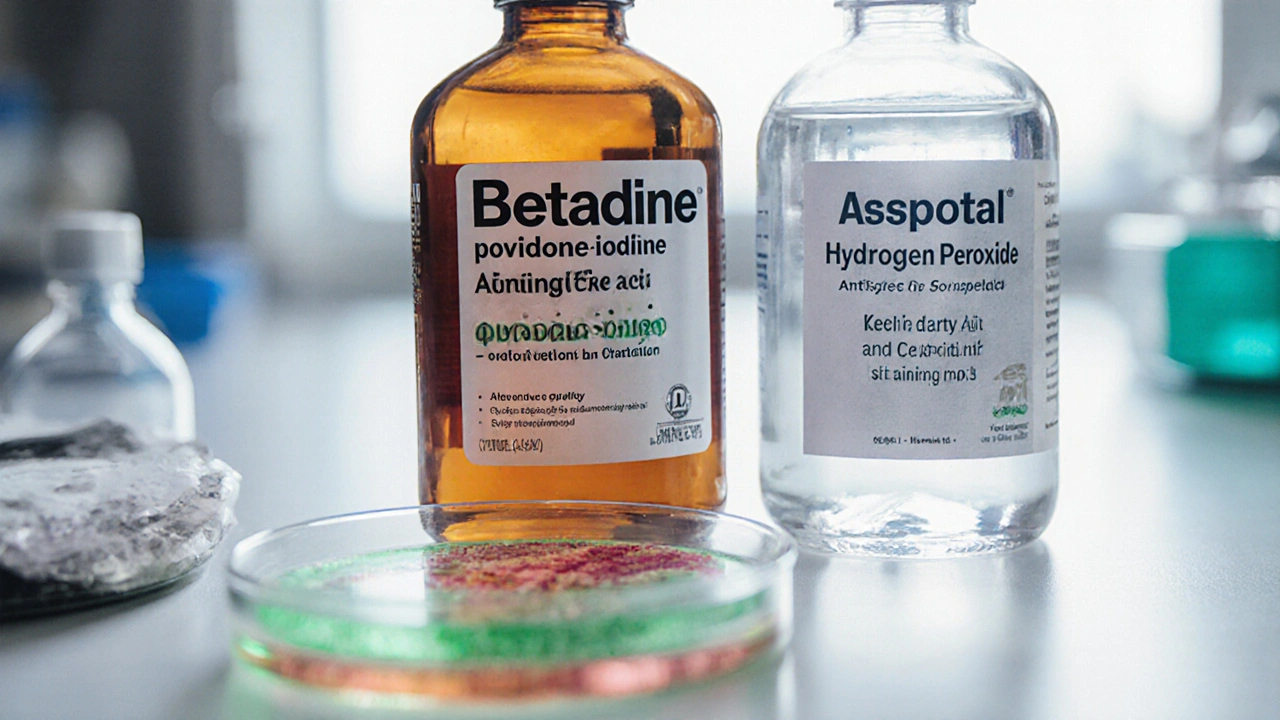When working with Betadine, a povidone‑iodine based antiseptic used for skin disinfection and wound care, also known as povidone‑iodine, it helps kill bacteria, viruses, and fungi on contact. Many people compare it to other common disinfectants like Chlorhexidine, a broad‑spectrum antiseptic often found in surgical scrubs and hydrogen peroxide, a bubbling agent that releases oxygen to cleanse wounds. Understanding how these products differ can prevent infections and speed healing.
Betadine is a type of povidone‑iodine, which means iodine is bound to a soluble polymer, releasing free iodine when applied. This release delivers rapid antimicrobial action, covering both Gram‑positive and Gram‑negative bacteria, plus many viruses and fungi. By contrast, Chlorhexidine works by disrupting cell membranes, offering a longer residual effect but less activity against spores. Hydrogen peroxide, while great for flushing debris, can be harsh on healthy tissue if overused. Each antiseptic also brings its own safety profile: Betadine may cause staining and occasional skin irritation, Chlorhexidine can trigger allergic reactions in sensitive individuals, and hydrogen peroxide can delay healing when concentrations are too high.
When you line up Betadine against its rivals, several attributes help you decide which one fits your situation. First, look at the spectrum of activity: Betadine covers a wide range of microbes, while Chlorhexidine excels against Staphylococcus species but falls short on certain yeasts. Second, consider the contact time required; Betadine works in seconds, whereas Chlorhexidine may need a minute to achieve full effect. Third, evaluate the comfort factor—alcohol swabs, another popular option, evaporate quickly but can sting and dry out skin, making Betadine a gentler choice for children or sensitive areas.
Cost and accessibility also shape the comparison. Betadine is widely stocked in pharmacies and often comes in various sizes, from small bottles for home use to large surgical prep packs. Chlorhexidine typically appears in wipes or solution forms, which can be pricier per milliliter. Hydrogen peroxide is inexpensive but less effective as a sole antiseptic for deep wounds. Finally, think about the setting: in hospitals, Betadine and Chlorhexidine are standard for pre‑operative skin prep, while in first‑aid kits, alcohol swabs or a small Betadine spray provide quick, reliable protection.
Another practical angle is storage and shelf life. Betadine remains stable for years if kept in a cool, dry place, whereas Chlorhexidine solutions may lose potency after opening if exposed to light. Hydrogen peroxide degrades quickly once opened, losing its bubbling power within weeks. Knowing these nuances helps you keep the right product ready for the right moment.
Safety warnings complete the picture. People with iodine allergies should avoid Betadine entirely and opt for Chlorhexidine or a non‑iodine cleanser. Those with thyroid issues need to be cautious with repeated Betadine use, as excess iodine can affect hormone balance. For pregnant or breastfeeding women, low‑concentration Betadine is generally considered safe, but it’s wise to consult a professional. In contrast, Chlorhexidine is contraindicated for use on the eyes or mucous membranes, while hydrogen peroxide can cause tissue damage if applied under occlusion.
Real‑world experiences often shed light on which antiseptic works best. Users report that Betadine’s brown stain fades after a few days, leaving the wound clean without a lingering odor. Chlorhexidine users appreciate the clear, non‑staining formula but note a metallic taste if it contacts the mouth. Hydrogen peroxide fans love the visual fizz that shows debris being lifted, yet many stop after a single use because the wound appears redder.
In a nutshell, a thorough Betadine comparison reveals that no single antiseptic wins every category. Betadine shines in broad antimicrobial coverage and ease of use, Chlorhexidine offers lasting protection for surgical settings, hydrogen peroxide provides mechanical cleaning, and alcohol swabs deliver rapid, stingy disinfection. Your choice should match the wound type, patient sensitivity, and practical considerations like cost and availability.
Below you’ll find a curated set of articles that dive deeper into each of these points—price guides, safety checklists, and step‑by‑step usage tips. Whether you’re a DIY first‑aid enthusiast or a healthcare professional, the collection will give you actionable insights to pick the right antiseptic for every situation.
Posted by
Paul Fletcher
15 Comments

A detailed side‑by‑side look at Betadine (povidone‑iodine) versus common antiseptic alternatives, covering effectiveness, safety, cost and best‑use scenarios.
read more